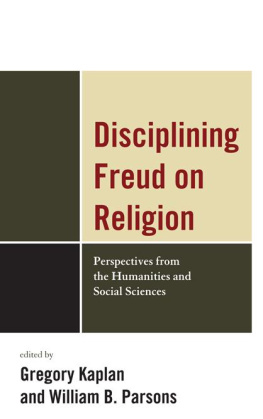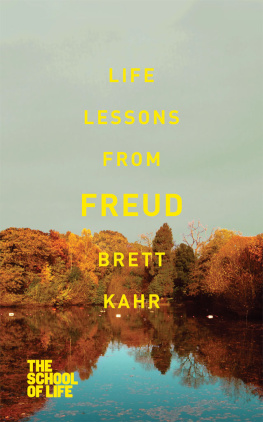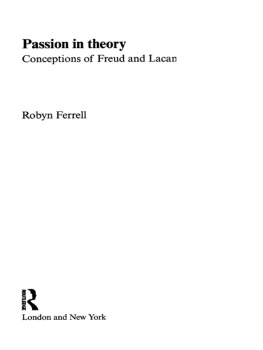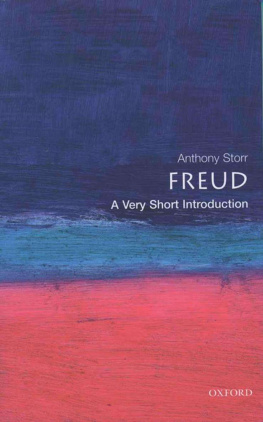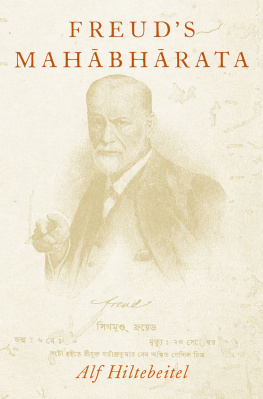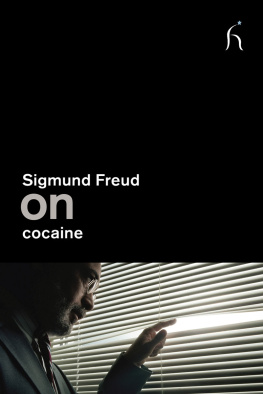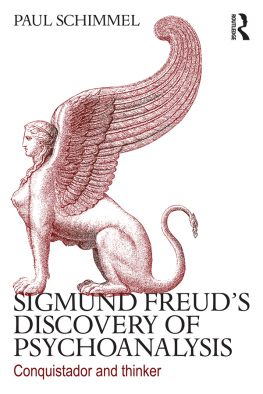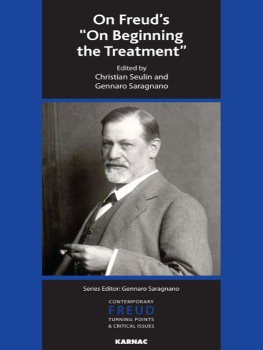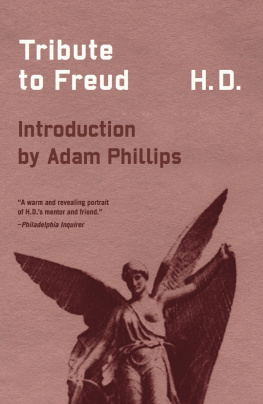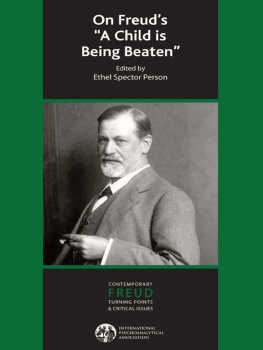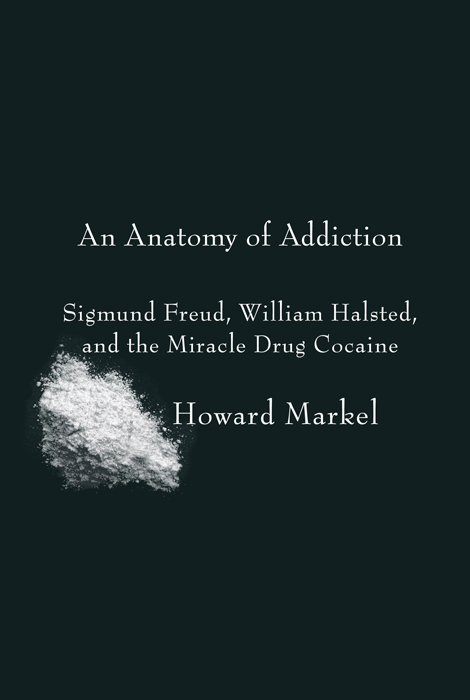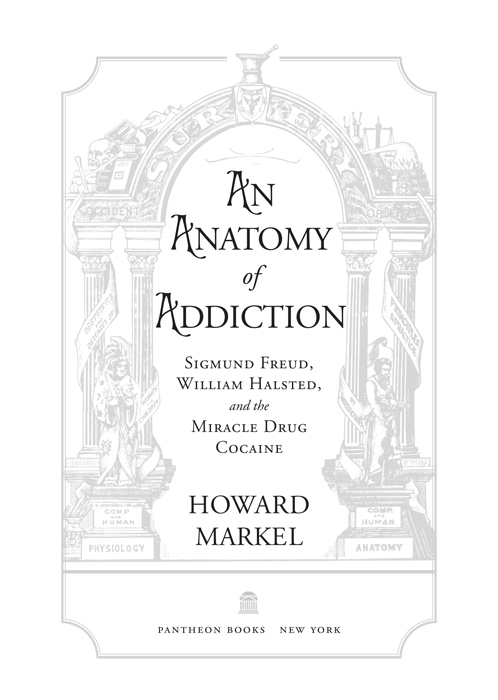Copyright 2011 by Howard Markel
All rights reserved. Published in the United States by Pantheon Books, a division of Random House, Inc., New York, and in Canada by Random House of Canada Limited, Toronto.
Pantheon Books and colophon are registered trademarks of Random House, Inc.
Library of Congress Cataloging-in-Publication Data Markel, Howard.
An anatomy of addiction : Sigmund Freud, William Halsted, and the miracle drug cocaine / Howard Markel.
p. cm.
Includes bibliographical references and index.
eISBN: 978-0-307-37981-8
1. Freud, Sigmund, 18561939. 2. PsychoanalystsAustriaBiography. 3. Halsted, William, 18521922. 4. SurgeonsUnited StatesBiography. 5. CocaineHistory. 6. Cocaine abuse. I. Title.
BF109.A1M37 2011 362.2980922dc22 2010033782
www.pantheonbooks.com
Jacket design by Peter Mendelsund
Book design by Virginia Tan
v3.1
For Bess and Sammy,
with love from Daddy
Contents
Acknowledgments
I T IS A PLEASURE TO ACKNOWLEDGE and thank those who helped convert this book from a mere idea into an actual volume.
To begin, I am most fortunate in finding an academic home at the University of Michigan in Ann Arbor. Working with so many talented scholars, scientists, and physicians in the midst of such extraordinary resources has advanced my work in more ways than I can enumerate. At the University of Michigan Center for the History of Medicine, I am grateful to Professor Alexandra Minna Stern for her warm friendship, encouragement, and careful reading of my work; Dr. J. Alexander Navarro, who is as able a digital and computer wizard as he is a historian; Mary Beth Reilly for her superb reference and fact-checking; and Scott Oosterdorp for his helpful library searches when I was otherwise occupied. I am indebted to Professor Daniel Herwitz, who directs the University of Michigan Institute for the Humanities, where I was the John Rich Professor during the 200506 academic year, and who patiently read every page of the manuscript, much to my delight and this books improvement. Similar thanks go to Professor Michael Schoenfeldt, the chairman of the University of Michigan Department of English Literature and Language. He is a treasured friend and a thoughtful reader.
From 2004 to 2010, I was fortunate to serve as a physician at the University of Michigan Addiction Treatment Service. There I saw hundreds of patients with substance abuse and addiction problems in collaboration with a dedicated and talented staff of psychiatrists, psychologists, and social workers. I thank the medical director, Dr. Kirk Brower (who also read and helped improve the scientific portions of this book), Dr. Robert Zucker, Dr. John Greden, Dr. Maher Karem-Hage, Michael Wallace, and Randall Pomeroy for teaching me so much about this stubborn and crafty disease. Although I am honor-bound to respect the anonymity of my patients and many members of the Ann Arbor recovery community whom I met along the way, I thank them as well for enriching my work and life. Their experiences, hopes, and strengths were essential in helping me to better understand Sigmund Freud and William Halsted.
I also thank Dr. David McDowell of Mount Sinai Medical School, Dr. Catherine DeAngelis, editor-in-chief of the Journal of the American Medical Association, Dr. James Harris of the Johns Hopkins Medical School, Dr. Sherwin B. Nuland of Yale University, Dr. Stephen Bergman (a.k.a. Samuel Shem, M.D.), Jonathan Cohn of The New Republic, Dr. Martin Cetron of the U.S. Centers for Disease Control and Prevention, Professor David Rosner of Columbia University, Don Bosco Hewlett, Eric Lax, and Dr. Sheldon F. Markel for taking the time to read the manuscript with careful and generous eyes.
All historians claim libraries as their workshops, but once there they rely heavily on the librarians and archivists who curate the historical collections. The staffs of the University of Michigan Libraries, the Bentley Historical Library of the University of Michigan (Francis Blouin, William Wallach, and Brian Williams), the Alan Mason Chesney Archives of the Johns Hopkins Medical Institutions (Nancy McCall and Andrew Harrison), the Weill Medical College at Cornell University/New York Hospital Archives (James Gehrlich), the Freud Museum of Vienna (Claudia Muchitsch, Christian Humber, and Martina Gasser), the Freud Museum of London (Carol Siegel), the Josephinum Medical History Museum at the University of Vienna (Dr. Ruth Koblizek), the Gesellschaft der rzte / Society of Physicians in Vienna (Manfred Gschwandtner), the Historical Collections of the New York Academy of Medicine, the New York Public Library, the Yale University Archives (Geoff Zonder), the F. L. Erhman Medical Library of the New York University School of Medicine (Colleen Bradley-Saunders), the Enoch Pratt Free Library of Baltimore, the National Library of Medicine, the Library of Congress, the British Library, and the Wellcome Library of the History of Medicine in London all performed their tasks with professionalism and speed. I hope that a collective thank-you will suffice.
I am also grateful to the Sigmund Freud Archives and the Sigmund Freud Collection at the Library of Congress for allowing me to quote several short passages from letters Sigmund wrote to his then fiance and later wife, Martha Bernays, and to many of his colleagues, including Wilhelm Fleiss.
My literary agents, Glen Hartley and Lynn Chu of Writers Representatives, are, quite simply, the best practitioners of their profession. They believed in this project from the very start and never flagged in their encouragement, creativity, and advice. It is a pleasure to thank them, once again.
This is the second book I have completed under the tutelage of my extraordinary editor, Victoria Wilson, vice president and associate publisher of Alfred A. Knopf. She continues to hold me to the highest standards of writing, and I am grateful for her wise suggestions and counsel. I am also indebted to her editorial assistant, Carmen Johnson, for her cheerful demeanor and professionalism; to copy editor Bonnie Thompson for her superb attention to questions of language, grammar, and factual detail; and to the entire staff at Pantheon, especially Ellen Feldman, who performed their jobs with insight and ability.
I must add that while all of these people have generously given me superb assistance, any errors or defects that remain in the book are mine alone. Those flaws, I hope, are neither glaring nor fatal.
Finally, I thank my family for their support and love during the past seven years as I tracked the lives of Sigmund and William. My wife, Kate Levin Markel, scrutinized and improved every page of this book. Our daughters, Bess Rachel, age ten, and Samantha Louise, age five and who answers to Sammy, are the lights of our lives. They never complained as I isolated myself during the throes of composition and were especially encouraging when the work was not always going smoothly. This book is dedicated to my wonderful girls and signifies my hope for their brilliant and healthy futures.
Howard Markel
Ann Arbor, Michigan
September 20, 2010
Illustrations
Bellevue ambulance, lower Manhattan, c. 1885. New York University School of Medicine, Ehrman Medical Library Archive
William Stewart Halsted, age twenty-eight, c. 1880. Alan Mason Chesney Archives of the Johns Hopkins Medical Institutions, Baltimore, Maryland


